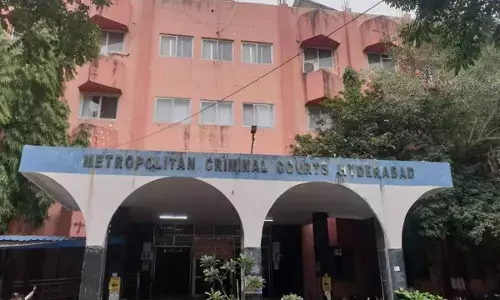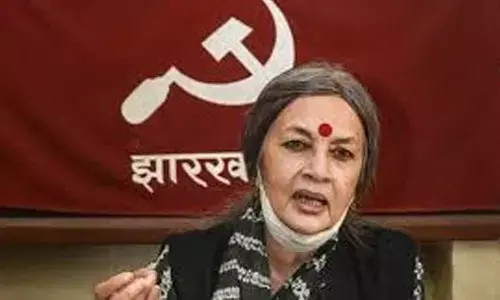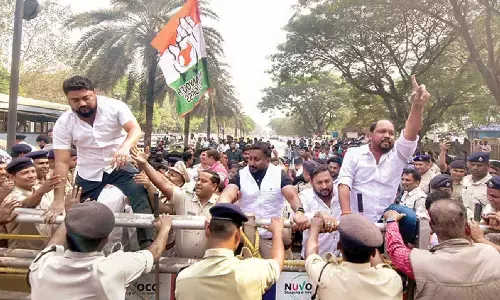A demon that swallowed livelihoods

Economic growth since 2012 failed to generate secure, regular and decent incomes for vast majority, particularly in unorganised and informal sector India is facing severe crises of employment and livelihood
Employment and well-placed labour produce in a country general prosperity, content and cheerfulness - Daniel Weber
Economic growth since 2012 failed to generate secure, regular and decent incomes for vast majority, particularly in unorganised and informal sector. India is facing severe crises of employment and livelihood.
As per official records, the growth rate in India between 2012-2016 July was impressive. However, due to untimely and ill-thought policies of demonetisation and completely morphed GST by the BJP and the Prime Minister led to crises in the economy.
With fluctuating growth rates between 2015-2018 August failing to create more jobs and increase in productivity in certain major sectors failing to spur a commensurate rise in incomes, demonetisation has thrown nearly 225 million people in rural- agricultural and informal sectors out of gears, which would take at least minimum three years for them to recover from the onslaught of shares of working capital.
A study group from Azim Premji University “Centre for Sustainable Employment” came out with some interesting facts. As per the study, divergence between growth and employment had increased over period. If one takes the period 1970-1980, when the GDP growth was as low at 3-4 percent, employment growth was about 2 percent.
Surprisingly, after 2013, the ratio of GDP growth and employment growth is less than 0.1 percent, particularly among educated youth. This implies a 10 percent increase in GDP results in less than 1 percent increase in employment. Employment actually declined by 7 million between 2013-2016. It is likely that the absolute decline continues in the following years.
It was expected that unemployment may rise to more than 5 percent after 2016. In geographical terms, Northern States of India are the most severely affected. Similarly, in demographic terms young people with higher education qualification levels suffered even if employment rate is as high as 16 percent.
While incomes are rising in a few sectors, the worrying fact is that rural wage growth collapsed after 2014 and has not risen since then. Besides, even in the organised manufacturing sector, the number of jobs has grown, there has also been an increase in the share of contract work offering low wages and less job security.
Also, the disquieting factor is the divergence of productivity and wages in the organised manufacturing sector. By 2015, labour productivity is six times higher than it was thirty year ago. However, managerial and supervisory personnel salaries have tripled during the same period, while low skilled and semi-skilled workers wages have grown a nearly 1.5 times.
Another dimension of employment situation is that female participation in the (paid) workforce is still very low. At the same time, there are wide differences among States in terms of women’s employment. While in Uttar Pradesh, only 20 women are in paid employment for every 100 men, the figure in Tamil Nadu is 50 and as high as 70 in Mizoram and Nagaland.
From the above, one can easily discern that their prevails not only gender inequality in caste ridden Hindi belt but also with regard to earnings. In fact, the caste gap is actually larger than the gender gap. It is ironical that Dalits and Adivasis are employed more in low-paid occupations, particular in BIMARU (Bihar, Madhya Pradesh, Rajasthan, and Uttar Pradesh) States. They earn hardly 50-55 percent of upper caste worker’s earnings.
According to Union Labour and Employment Ministry Wing on Employment Survey in 2012, the number of unemployed in the country was around 1.71 crore. By 2016 this figure reached 2.33 crores, almost doubled in five years. At the same time, in 2014 percentage of unemployment among youth was 3.8 percent, it has gone up to 5 percent by 2016.
All these low-paid workers are hard-hit during 2016-17 due to demonetisation denying livelihood with no relief measures being taken by either the Central government or northern States.
The Ministry of Statistics and Programme implementations should have developed times series data on employment particularly in rural-informal sector. The reason why this is needed is, technology is fast changing. For example, India has industries like textiles, jute, paper and sugar. Now, they are not so labour intensive in many of the southeast Asian nations.
Here we need employment data, tie up with GDP and sectoral growth particular rural-informal and small-scale sectors. It is a pity that business newspapers focus on corporate sector indicating that corporate investment is picking up and India is shining. But the real factor is that these newspapers never concentrate on non-corporate sector which provides larger employment opportunities to low and semi-skilled workforce both male and female.
The government of India ill- conceived and poorly implemented demonetisation on rural sectors is disastrous and has virtually broken the backbone of informal sector. The informal sector accounts for 20 percent of GDP and 80 percent of employment. The rural India is home to two- thirds of India’s population. It is high time India needs to develop formal and informal employment data of rural-India.
The World Bank in 2018 released a report on “South Asian Growth and Employment Situation”. The report especially mentioned India’s employment situation which reveals that to maintain employment rate, India needed to add 80 lakh jobs every year in future. As per World Hunger Index, India’s position is at 97 in 2016 has versioned in 2018 at 108 out of 119 countries taken for review, even in most of the States in India, employment generation both in the public sector and private organised sector is not as expected.
Almost 40 percent of government job vacancies are not filled because of unproductive expenditure on popular measures. Even in private sector, job creation is disappointing. According to ASSOCHAM, as Indian economy growth is slowed and due to government policies, campus selections have declined to 45% between 2014-16. By encouraging manufacturing sectors, which have spread effects, Japan, South Korea and China could increase job creation rapidly between 2009-2014.
Unfortunately, India’s manufacturing sector growth is slow and still in infancy stage. There is urgent need for fresh thinking without any ideology pre-commitment. In a democratic welfare State, every Indian should be ensured to lead a secure dignified life in a just and sustainable way. (The writers are faculty members at UCA&SS, Osmania University. The opinions expressed are personal)
By Prof A V V S K Rao & Dr M Ramulu












